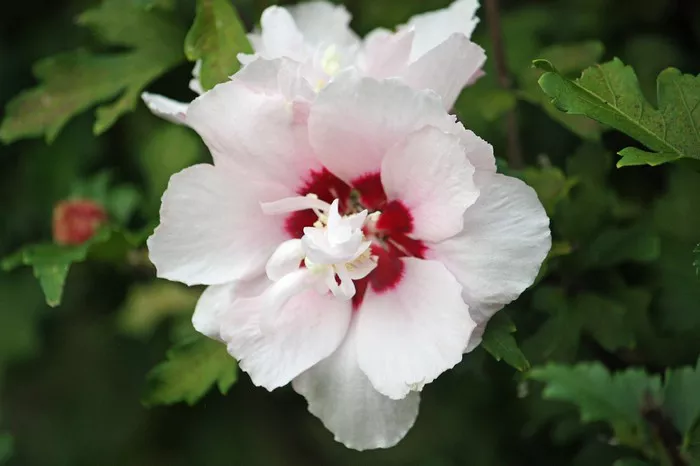In the realm of horticulture, few flowers command as much attention and admiration as the Rose of Sharon. Known for its captivating beauty and cultural significance, this flowering plant has become a symbol of elegance and grace. In this article, we will delve into the intricate details of what makes the Rose of Sharon flower truly special, exploring its physical characteristics, varieties, and cultural relevance.
Physical Characteristics:
The Rose of Sharon, scientifically known as Hibiscus syriacus, is a deciduous shrub that belongs to the family Malvaceae. This stunning plant is native to East Asia but has found a second home in gardens around the world due to its alluring aesthetics. The flower’s defining feature is its large, trumpet-shaped blooms that showcase a mesmerizing blend of colors. Typically measuring around 2 to 4 inches in diameter, the petals of the Rose of Sharon exhibit a remarkable diversity in hues, ranging from pristine whites to vibrant pinks, purples, and blues.
The Blossoming Beauty: A Visual Symphony
The Rose of Sharon flower is a visual symphony that unfolds in late summer to early fall, gracing gardens with its enchanting presence. The trumpet-shaped blooms unfurl delicately, revealing a central staminal column surrounded by a multitude of petals. The contrasting colors and intricate patterns make each flower a unique masterpiece, drawing the gaze of admirers and pollinators alike.
Varieties of Rose of Sharon:
One of the captivating aspects of the Rose of Sharon is the wide array of cultivars and varieties available, each boasting its own distinct charm. These variations in color, size, and petal structure provide gardeners with the opportunity to select the perfect complement for their landscape. Some popular varieties include:
1. Blue Chiffon: This cultivar is celebrated for its double blue-violet blooms, resembling delicate chiffon fabric. The ethereal quality of the flowers adds a touch of sophistication to any garden.
2. Aphrodite: Named after the Greek goddess of love, this variety features large, vibrant pink blooms with a deep red eye at the center. The Aphrodite Rose of Sharon exudes a sense of romance and passion.
3. White Chiffon: As the counterpart to Blue Chiffon, White Chiffon offers elegant, double blooms in pure white. The simplicity of these flowers brings a classic and timeless beauty to garden landscapes.
4. Woodbridge: With its semi-double lavender-pink flowers, the Woodbridge variety is known for its compact growth habit. This makes it an excellent choice for smaller gardens or as a focal point in mixed borders.
Cultural Symbolism and Significance:
Beyond its physical allure, the Rose of Sharon holds cultural and symbolic importance in various societies. The name “Rose of Sharon” is derived from the Bible, specifically the Song of Solomon, where it is used as a poetic reference to beauty and abundance. In Korean culture, the flower is known as “Mugunghwa” and is the national flower of South Korea, symbolizing immortality, fidelity, and everlasting love.
Historical and Cultural Significance:
The Rose of Sharon’s historical significance is deeply rooted in the East, where it has been cultivated for centuries. In Korea, the flower is often associated with national pride and resilience, having survived wars and upheavals. Its depiction in art and literature further cements its place as a symbol of enduring beauty and strength.
Blooms of Resilience: A Cultural Odyssey
As an enduring symbol in various cultures, the Rose of Sharon’s blooms tell a tale of resilience and fortitude. Its ability to thrive in diverse climates and its capacity to withstand the test of time have made it an emblem of endurance and tenacity.
Gardening Tips for Rose of Sharon:
For those enchanted by the beauty of the Rose of Sharon and eager to cultivate this stunning flower in their own gardens, here are some essential tips:
1. Sunlight: Rose of Sharon thrives in full sunlight, so ensure it receives at least six hours of direct sunlight each day.
2. Soil: Well-drained soil is crucial for the Rose of Sharon. It prefers slightly acidic to neutral soil with good fertility.
3. Watering: While the plant is relatively drought-tolerant once established, regular watering is essential during dry spells, especially during the flowering season.
4. Pruning: Prune the Rose of Sharon in late winter or early spring to encourage a more compact shape and enhance flowering.
5. Fertilization: Apply a balanced, slow-release fertilizer in spring to support healthy growth and abundant blooms.
Conclusion
In conclusion, the Rose of Sharon stands as a testament to nature’s artistry, captivating the hearts of gardeners, poets, and admirers worldwide. Its enchanting blossoms, rich cultural symbolism, and adaptability make it a cherished addition to gardens, both for its visual splendor and the stories it carries. As we revel in the elegance of the Rose of Sharon, we are reminded of the profound connection between nature and human culture, where beauty and meaning intertwine in a symphony of petals and symbolism.


